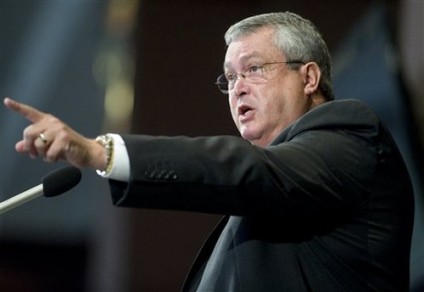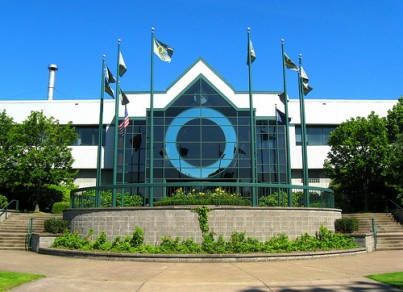When college football fans hear the words “innovation” and “Oregon” in the same sentence, most would immediately picture Chip Kelly’s high-speed spread offense or the Ducks’ deep selection of sleek uniforms.
However, before Oregon’s modern era of immense creativity and success, the football program required a period of rapid innovation on a much more basic level, a level that is often overlooked because it occurs behind the scenes.
For a college football program to be successful, the school needs more than good coaching. The Ducks proved this to be true in 1982, the year that Bill Byrne came to the University of Oregon as associate athletics director, finishing 2-8-1 despite the presence of head coach Rich Brooks.
Thirty years ago Oregon’s football team had made a home for themselves in the Pac-10 cellar, and many modern Duck fans would hardly even recognize the program that they know and love today.
The program was struggling so much, in fact, that some of the California schools (such as UCLA and USC, who had defeated Oregon by a combined margin of 59 points in 1982) were considering removing the Ducks from the conference entirely.
The team did not even have the luxury of a true practice space separate from Autzen Stadium, often having to probe the campus in search of an empty intramural field.
In this day and age of Oregon football, where the Ducks have lost only seven games over the last four seasons, those images are so foreign that they seem almost unthinkable. Four consecutive BCS bowls and three conference championships in the last four years … how did we get here? Who do we have to thank?
Many assume the answer is simple: Phil Knight. They’re not exactly wrong to say so. Phil Knight’s donations to the school and its athletics department have been invaluable over the years, and Duck faithful have a lot to be grateful for.
Others might say Chip Kelly, whose brilliant offensive mind has brought the Ducks to new heights since he joined the program as offensive coordinator in 2007.
In reality, we Duck fans have plenty of people to thank. However, one man seems to fly under the radar.
Bill Byrne is a name that many Oregon fans, especially among the younger generations, have never heard. He was a silent leader who managed to make a lot of noise in the way of fund raising. Byrne is a man to whom many fans do not know what they owe.
As much as I love Eugene and its endearing rainy climate, I recognize that not a lot of 17-year-old high-profile football recruits from other parts of the country would feel the same way. California recruits, for example, have USC, UCLA, Cal, and Stanford right in their backyard, and many would prefer their sunny campuses and storied academic traditions to Oregon’s out-of-state program, especially in the 1980s when the Ducks were struggling.
In a lot of ways, Oregon struggles to compete with that. After all, how could a small college town in the Willamette Valley outsell the bustling city life of Los Angeles to some of these teenaged superstars?
Well … the facilities are one answer. Oregon’s athletic facilities are among the best, if not the best in the nation. However, this wasn’t always the case.
“We came to the conclusion we had good coaches, but we didn’t have the athletes,” said Oregon’s former vice president for admissions Dan Williams according to The Oregonian. ”And the reason we didn’t have the athletes was because we didn’t have the facilities.”
When Byrne took over as athletic director in 1983, he wasted no time in improving the Oregon football program. One of the first items on his checklist was the construction of a real practice field for the team.
Byrne’s innovation helped to solve this problem when he came up with the idea to ask Eugene’s local farmers for help. Many responded with grass seed donations in order to build the Ducks a practice field right next to Autzen Stadium.
With a real practice field and an expanding budget, the Oregon football program was driving itself out of mediocrity, and Byrne was behind the wheel. By 1989, the Ducks followed a 7-4 regular season with a trip to the Independence Bowl, their first bowl berth since 1963.
However, the process wasn’t that simple. The bowl committee was reluctant to give Oregon the bid at first, fearing that Duck fans wouldn’t make the trip to Shreveport to watch the game. Byrne rolled the dice and purchased a large number of tickets to ensure the Ducks’ spot in the game.
“We had to buy 11,000 or 12,000 tickets,” Byrne said. ”But we had to do that to show the bowls that we were capable of having fans follow us.”
Oregon defeated Tulsa 27-24 in front of a crowd full of Duck fans, improving to 8-4 on the season. Byrne’s risky move and the 1989 Independence Bowl victory put the Oregon football program on the national map.
Shortly thereafter, in 1991, the Casanova Center was completed with the help of Byrne’s leadership and fund raising. The Cas came with greatly improved coaching offices, film rooms, locker rooms, weight rooms, and many other assets that have contributed to Oregon’s success.
The university’s strength and conditioning coach, Jim Radcliffe, recalled that some recruits used to laugh upon entering the Ducks’ old weight room because it was smaller than the ones at some of their high schools.
The Cas has now become a staple of Oregon football, and is a big pull factor for recruits to come to Eugene.
Byrne’s contributions to the Oregon football program are almost too extensive to keep track of. Over his eight years as athletic director, he increased the department’s budget from $5.2 million to about $13 million. On top of the building projects previously mentioned, he facilitated drastic improvements to Autzen Stadium and Hayward Field as well.
His contributions to the university’s athletics were also, of course, not limited to football. For example, Byrne famously took on the job of re-painting the floor of Mac Court himself due to a lack of funds.
“Uncle Phil” may be the most famous donor to the University of Oregon and its athletics department, but Oregon football has Bill Byrne to thank for dragging the program out of mediocrity and onto the national stage.
Though Byrne left the university in 1992, his legacy lives on. Thanks to his leadership, fund raising, innovation, and desire to improve the program, the Ducks now consistently find themselves atop the national rankings, a far cry from where they were in 1982 when Byrne first stepped foot on campus.
Joey Holland graduated from the University of Oregon in 2013, majoring in History. He played several sports in high school, though football remains his passion. He has yet to miss a single Oregon Ducks home football game during his time in Eugene. Joey has written previously for Bleacher Report and Football Nation.
Joey welcomes your feedback.


